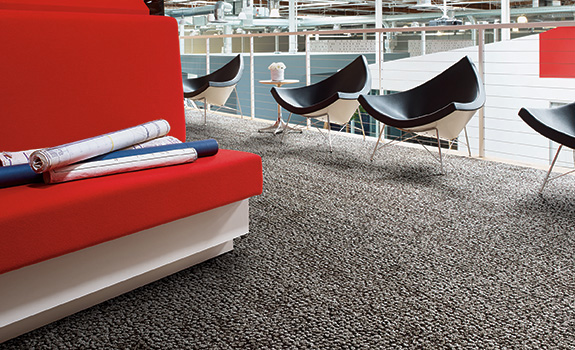If there’s truth to the adage that we’re all products of our environment, then it makes good sense to ensure the spaces we work in are as conducive to bringing out the best in us as possible.
There’s a lot of buzz in design circles these days around the idea of biophilia—the notion that humans possess an instinctive tendency to seek out connections with nature and other forms of life. Described in 1973 by the German-born American psychoanalyst Erich Fromm as “the passionate love of life and all that is alive,” and expanded on in 1984 by American biologist Edward O. Wilson, who proposed that the human proclivity to affiliate with nature and other forms of life is based, in part, on genetics, biophilia has become the foundation for a movement among proponents of sustainable design to incorporate aspects of nature into products and spaces to support a sense of well-being that’s vital to human health and productivity.
There’s also a growing body of anecdotal and scientific research that validates the benefits generated by a proximity to nature—or elements that mimic it—and supports the trend toward nature-centric design. Read on for five expert design strategies that rely on nature or biomimicry to enhance our health and well-being in built environments.
Cultivate a green wall
Living walls composed of an array of small plants not only delight the senses by bringing color and dimension to lobbies, atriums, and other communal spaces, they also promote health and well-being by absorbing carbon-dioxide and other toxic gasses and replacing them with life-giving oxygen.
As an alternative to green walls composed of grasses, succulents, and other plants, Joseph Zazzera, a certified biomimicry professional, LEED AP ID+C, provisional WELL AP, and co-owner of Scottsdale, Arizona-based Plant Solutions, suggests installing a low-maintenance green wall made of moss and lichens, which Buddhist monks began to cultivate a thousand years ago in temples or on stones and walls to turn their attention away from daily distractions and facilitate meditation. When their varying textures and chartreuse, olive, soft gray, and pale green hues are coalesced within a framed composition, maintained with a patented preservation process, and mounted on a wall, mosses and lichens also engage the eye like an abstract painting. “We think of these as biomimicry art pieces, connecting us to our human nature and innate love of living things,” says Zazzera. “Each one is like a shrine at the edge of the wilderness between our offices and our primeval nature.”

Living walls composed of an array of small plants not only delight the senses but also promote health and well-being by absorbing carbon-dioxide and replacing it with oxygen. Image credit: ©Plant Solutions
Consider the senses
Nature-inspired elements that we can see, hear, smell, or feel can positively impact our physical and mental well-being and also reduce stress. A work space that supports eye health, for example, should allow for depth of view beyond computer screen of at least 20 feet, but ideally 60-100+ feet, to allow eye muscles to completely relax and prevent prolonged ocular stress, according to Chris Garvin, AIA, LEED AP BD+C, and managing partner with Terrapin Bright Green, a sustainability consulting and strategic planning firm.
“If you have manual controls for window blinds, be sure to use them and not keep the blinds down out of forgetfulness,” Garvin says, who also advises incorporating the sound of running water in work spaces as well. “Trickling or gurgling water can contribute to concentration and stress reduction,” he explains. “A small desktop fountain can cost as little as $10.” To address the sense of touch, Garvin recommends incorporating a sense of “thermal variability,” in air flow or temperature “either through manual controls, operable windows, an oscillating small desktop fan, or material choices with different thermal qualities—including a mix of metal, wood, fabric and other material surfaces.”

Nature-inspired elements can positively impact our physical and mental well-being and also reduce stress.
Echo nature’s textures, forms, and patterns
From crystals and leaves to seashells and snowflakes, the naturally occurring forms in nature are built upon patterns that humans instinctively respond to in a positive way. The late designer Buckminster Fuller looked to these patterns as the ultimate source of inspiration in his whole-systems approach to problem solving. “Fuller was impressed with how efficient nature is in her use of materials,” says Elizabeth Thompson, executive director of the Buckminster Fuller Institute. “As a result, none of his structures have right angles because nature doesn’t use them—natural forms are all based on the triangle and tetrahedron,” she adds.
When surrounded by structures or elements based on such patterns, she explains, “you feel something that has a resonance with the natural world.” The use of biomorphic forms, or forms that mimic those in nature, has been found to reduce stress and increase visual preference, concurs Garvin. “This would also include the use of fractal ratios and other patterns that occur within nature,” he notes.

The flooring options in Interface’s Human Nature trigger positive signals in the brain by bringing a sense of nature underfoot with both textures and patterns that emulate moss, sand, gravel, and other natural surfaces.
Open a window on the world
As workspaces shrink to reduce carbon footprints and limit energy and real estate costs, designers, facility managers, and corporate decision-makers have found that introducing a view onto a natural setting can compensate for a perceived loss of space. As an example, Lindsay James, a certified biomimicry professional and vice president of restorative enterprise for Interface, points to furniture manufacturer Haworth’s renovated headquarters in Holland, Michigan, where more traditional offices were exchanged for updated smaller-scale open workspaces, and an enclosed garage was removed and replaced with prairie grasses and an atrium to provide access to daylight and views.
“An early post-occupancy survey revealed a negative response at first, as workers felt the space to be more crowded, but over time a family of wild turkeys moved in to the prairie and people began to check daily on the eggs as they were nurtured and hatched,” she explains. “After workers reconnected to the rhythm of life, positive responses went up dramatically in a subsequent survey as they found unexpected fulfillment in witnessing nature at a slow pace,” she adds. “As we see nature unfolding over the seasons, we are reminded on a daily basis of how the bigger picture can affect our world view and reinforce the feeling that we’re connected to all life on the planet.”

Haworth’s renovated headquarters in Holland, Michigan exchanged more traditional offices for updated smaller-scale open workspaces. An enclosed garage was removed and replaced with prairie grasses and an atrium to provide access to daylight and views. Image credit: Haworth
Follow the light
“Daylight, with a sky view and exposure to natural diurnal patterns, supports concentration during the day and helps maintain healthy circadian rhythms,” says Garvin. “When quality daylight isn’t possible, one strategy is task-ambient electric circadian lighting design with biologically-correct LED light bulbs for task lamps.”
One response to “Natural Healing with Biophilia”
[…] here we are, decades into our love affair, and we are still learning from you—how your patterns can heal us, how your models can guide us. And we believe that reconnecting with our love for you will not only […]